I’ve been making my Thai chicken satay for years, tweaking it here and there until I landed on this perfect recipe, which not only tastes better than takeaway, you can make it quicker too.
- Surprisingly easy to make.
- The quickest way to skewer chicken ever!
- It benefits from marinating for a short time but you can speed it up.
- Tastes as good as take-out Thai satay.
- Served with an addictively tasty homemade Thai peanut satay sauce.
- A combo of classic and convenient ingredients – authentic flavour without the running around.
Want another great Thai appetiser? Try these Thai fish cakes.
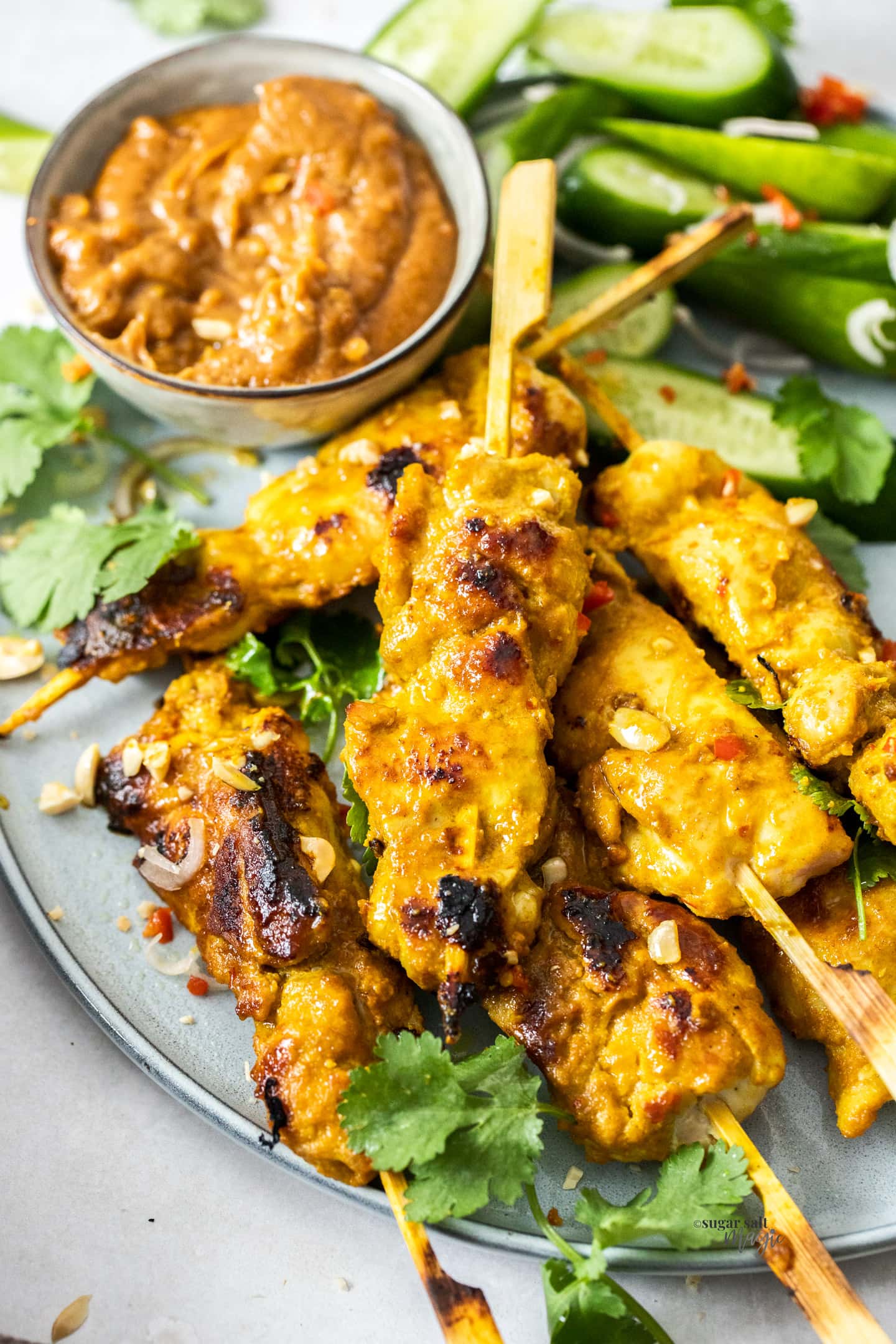
Table of contents
What is satay?
Satay (English spelling) is a southeast Asian dish of marinated meat on skewers, grilled, often over direct flame and generally served with a sauce. While satay originated in Indonesia, there is a version of it in just about every Asian cuisine, each with their own spicing and method.
Due to the popularity of Thai restaurants the world over, Thai satay has become very popular and Thailand is often mistaken as it’s origin. In Thailand, satay chicken is called “sate kai”.
Never Miss a Recipe!
Get the latest recipes straight to your inbox!
Satay ingredients
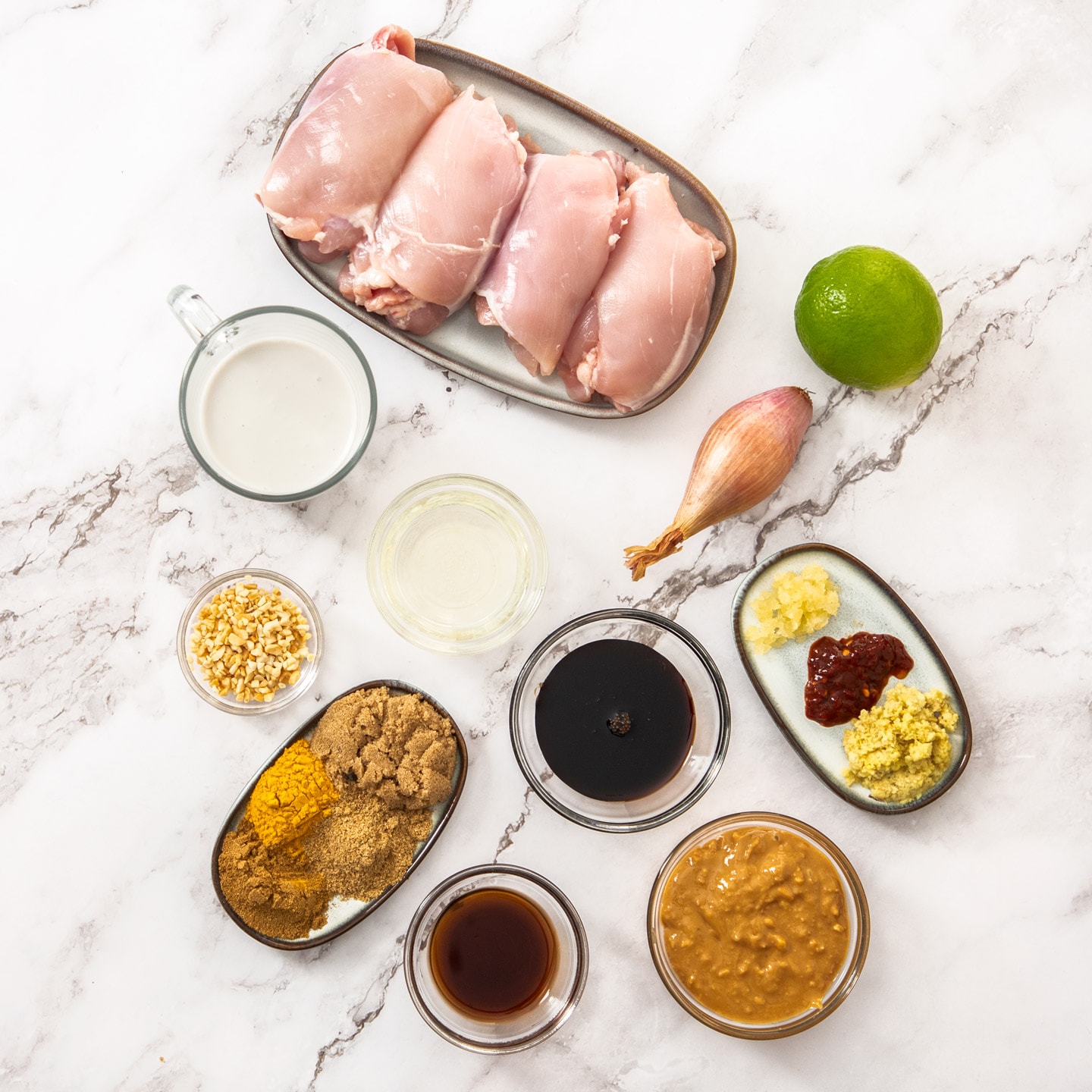
It may be a little different from authentic satay you’d find at street vendors in Thailand but my recipe is very close and certainly as good, if not better, than your local Thai restaurant.
My satay recipe uses mostly classic ingredients with a couple swapped for convenience so you can everything in your local grocery store.
Detailed quantities and instructions in the recipe card below.
For the chicken satay:
- Chicken thighs: You can use boneless skinless chicken thighs like I do or feel free to swap it for chicken breast. For that matter, loads of meats go well with satay – try pork or beef too.
- Shallot: I use the more common French shallot in place of Thai shallots (which are similar but have a smaller bulb).
- Garlic and ginger: For the best flavour, you must use fresh garlic and fresh ginger, both minced. The ground versions just won’t give you the same punch of flavour, or the same flavour in general.
- Fish sauce: An absolute classic Thai ingredient, fish sauce adds saltiness and flavour. It smells very pungent, some like it (aka my mum), some don’t (aka me), but the flavour is outstanding and I never cook Thai food without it.
- Spices: Ground coriander, ground turmeric and ground cumin add the perfect flavouring to the satay marinade.
- Sugar: I use brown sugar in this. If you want to be more authentic, grab yourself some palm sugar (it comes in blocks that you’ll need to grate).
- Chilli: Technically, you would use Thai chillis, also know as Birdseye chilies. They pack a heat punch so if you use these, make sure to use them to taste. I keep things simple by using jarred chilli paste. I can easily adjust the heat of what I’m cooking and it keeps in the fridge forever. You could also use sambal oelek in it’s place.
- Lime juice: While lime is used a lot in Thai cooking, usually you’d use either lemongrass or tamarind paste in satay. Tamarind paste has the sour tang that lime juice has but also adds some sweetness. If you use tamarind, just use the same amount as the lime juice. Lemongrass should be chopped roughly before adding to the blender.
- Oil: I use peanut oil but you can use any neutral-flavoured vegetable oil.
For the satay peanut sauce:
- Peanut butter: I use natural peanut butter in favour of grinding down peanuts from scratch. It’s not as inauthentic as it may sound – you must use natural peanut butter – it’s perfect since it’s just ground peanuts anyway so it saves time for the exact same thing. You can use smooth or crunchy.
- Coconut milk: Another favourite in Thai cuisines, coconut milk gives authentic flavour and makes it saucy.
- Kecap manis: You’ll find kecap manis in the Asian section of any grocery store. It is also known as sweet soy sauce.
- Chopped peanuts: Totally optional but I love the crunch of adding some chopped peanuts into the sauce.
- As with the marinade, you’ll also need fish sauce, lime juice and sugar.
I developed my recipe over years of trial and error. Using my favourite shop-bought satay seasoning as a starting point for working out the flavours, I created the perfect marinade (it’s so so good). Then the sauce is nice and thick and one I’ve tweaked here and there until it turned into the most addictive peanut sauce ever.
Love Thai food? Check out my Essential Thai Ingredients.
How to make satay chicken (step-by-step)
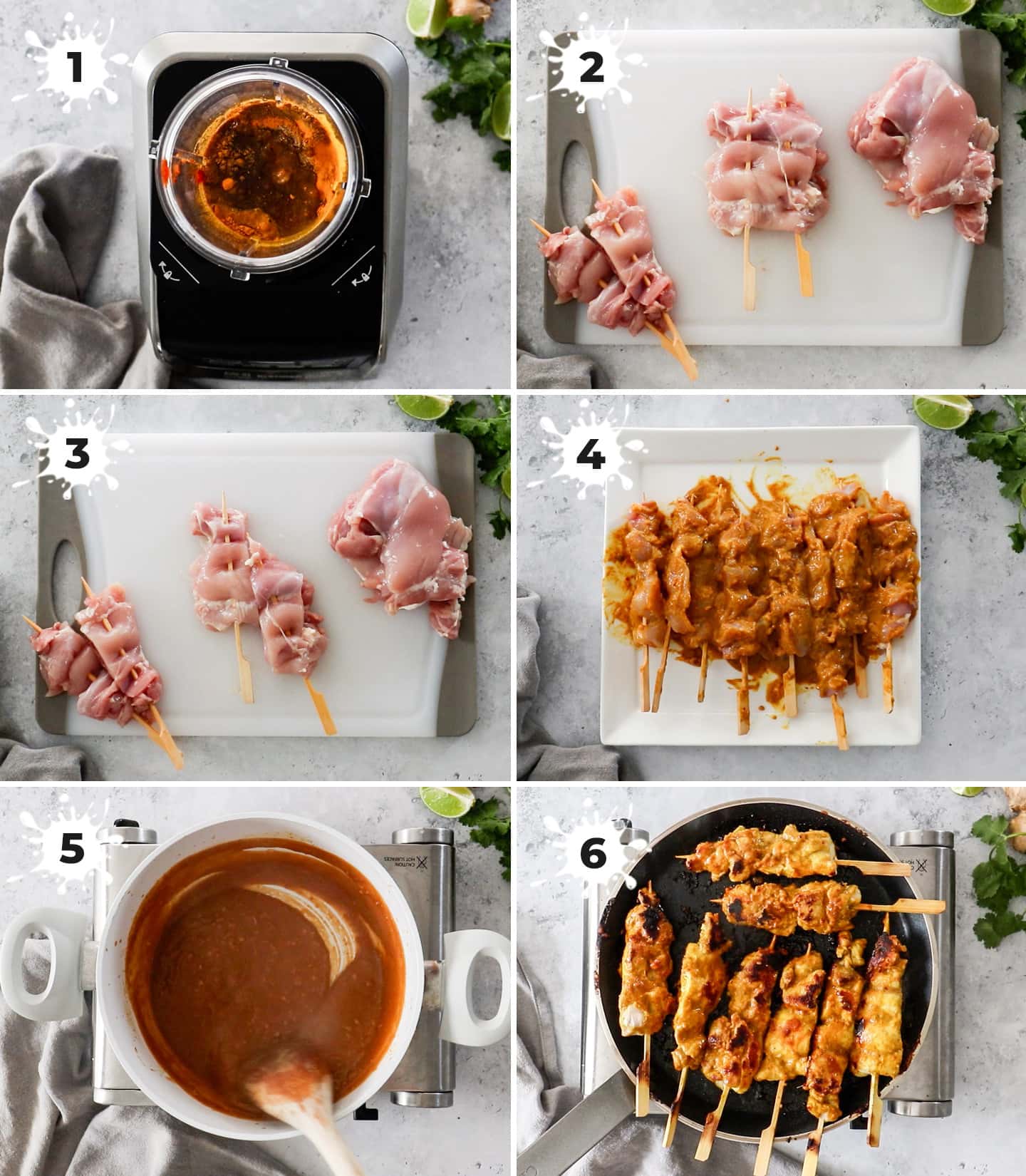
Detailed quantities and instructions in the recipe card below.
The satay marinade:
Making the marinade is as simple as adding everything to a blender (photo 1) and blending until it’s smooth. You’ll end up with a thick, yellowy-orange sauce, and you should be able to taste sweetness and tang but also the shallot is quite prominent.
Marinating the chicken:
First you’re going to skewer the chicken. If you’re using bamboo skewers it’s a good idea to soak them for 30 minutes first – this will stop them from burning.
Now to the simplest method to skewer the chicken ever! Take 1 chicken thigh and point the shortest side towards you. About 1.5 cm (roughly ½ inch) in from the edge, thread the skewer all the way through but pushing it up and down through the chicken (as opposed to just going straight). Now do the same on the other side (photo 2). Take a knife and cut straight down the middle and bam! You’ve got 2 satay skewers (photo 3).
Pour the satay marinade all over the chicken, coating it well (photo 4) and marinade for ½ an hour. You can do this for as little as 10 minutes but you’ll get a better flavour from marinating a little longer.
The homemade satay sauce:
Also incredibly easy, just combine the ingredients in a saucepan over medium heat and mix well. Bring it to a bubble, then let it simmer for a couple of minutes (photo 5).
The longer you simmer the sauce, the thicker it will get. I love it really thick and perfect for dolloping more than dipping but you can thin it out to your desired consistency with coconut milk or water.
Cooking the satay chicken:
I most often use a flat grill plate that sits on my stove top to grill my chicken satay skewers but in the images you can see I used a crepe pan. What you need is something flat – if the sticks are leaning up against the side of a pan, then chicken closest to the end of the skewer may not cook properly. If use a skillet or frypan, you’ll have to make sure the skewers sit flat inside it, not leant up against the side.
The skewers are grilled over medium heat for around 10 minutes until cooked through and there’s a little char on them (photo 6).
Tips and tricks
- Soak the skewers: The wooden skewers can burn if you use them dry so you’re best off to soak them at least ½ an hour first.
- Can I metal skewers? Metal skewers will get hotter than bamboo skewers so, firstly, be very careful when handling them and secondly, this means they will be cooking the chicken from the inside too so it will cook quicker.
- Adjust the sauce consistency to your tastes: In our house we love our peanut sauce thick and perfect for dolloping onto the skewers but you can thin it using a little extra coconut milk or water.
- Don’t feel like skewering the chicken? Just use chicken tenders or chicken breast cut into tender sized pieces.
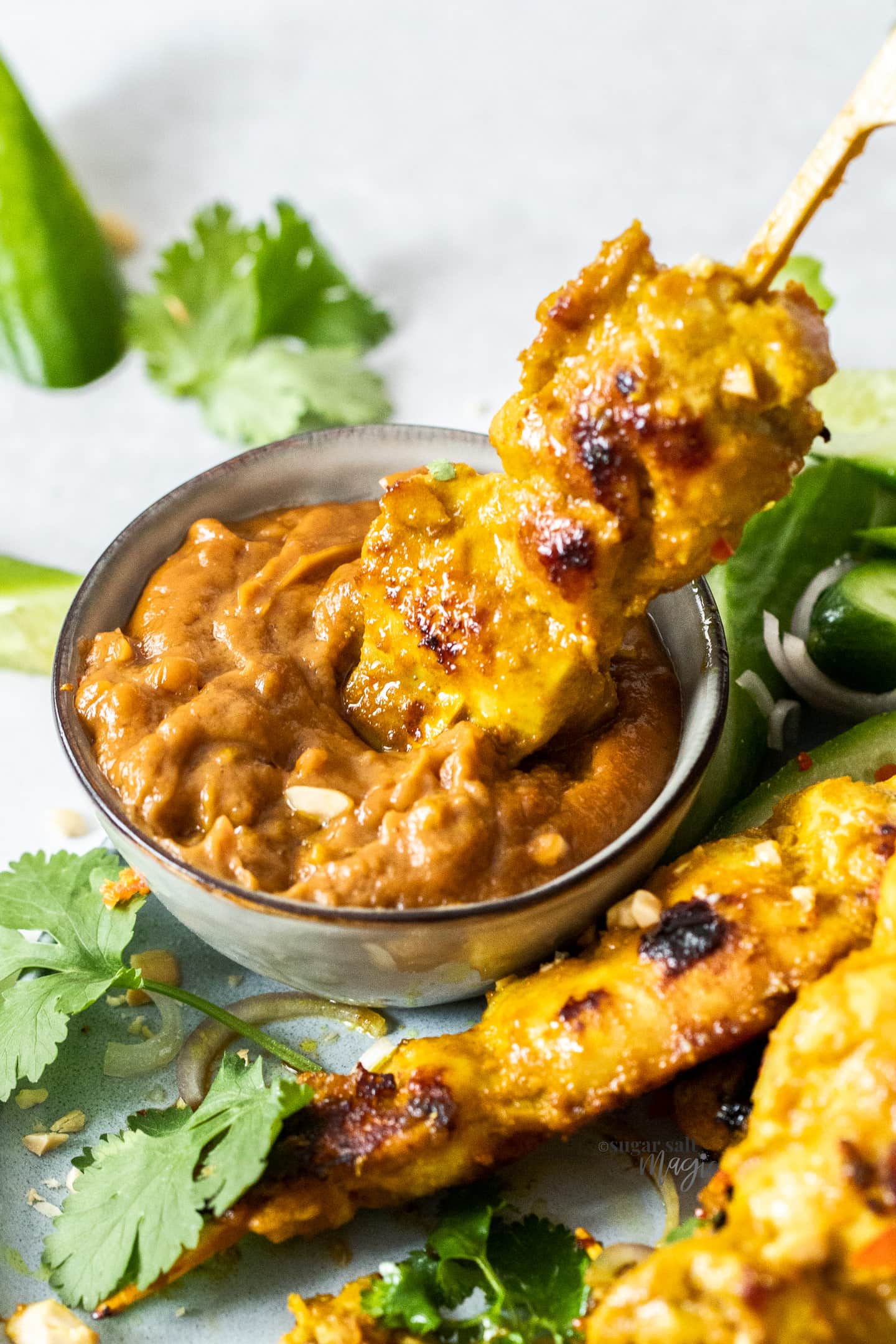
What to serve with thai satay
You’ll often find Thai satay chicken (or other satay meats) served with ajaat (a Thai cucumber relish) or nam jim dressing. I serve ajaat with my sesame prawn toast and you can find the simple recipe in the post there. It’s very quick and easy and a lovely sweet, spicy and tangy sauce.
If you serve it with the peanut sauce and don’t want a second sauce, serve your skewers with a simple cucumber salad of chunky chopped cucumber, a sprinkling of chopped peanuts and shallot and of course, steamed rice or coconut rice. Make sure to scatter over some fresh coriander / cilantro too.
Satay can be served as an appetizer (with chunks of cucumber on the side) or as a main dish when you add rice.
Yield and storage
The yield for this Thai chicken satay recipe is 3-4 serves (2 sticks each) though it will depend on the size of your chicken thighs. There is plenty of marinade so feel free to add an extra thigh if you want to give everyone more than 2 sticks.
Any leftovers should be stored in an airtight container in the fridge for 2-3 days. It can be reheated in the microwave or on the grill plate again.
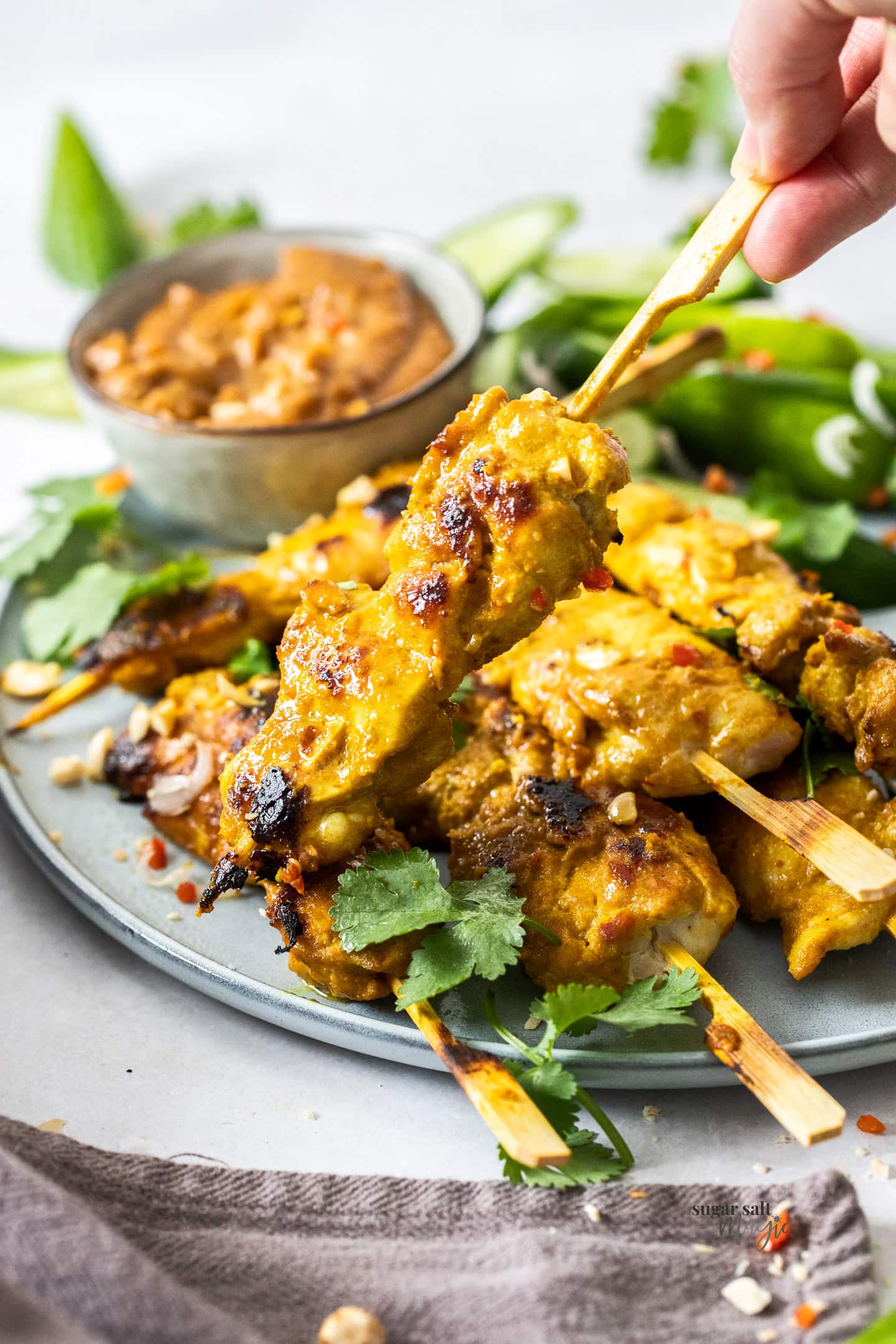
More recipes you’ll love
- Thai Panang curry with prawns
- Thai green chicken curry
- Thai green curry paste
- Honey pepper pork stirfry
- Chinese prawn fried rice
- Salt and pepper prawns (shrimp)
Did you try this Thai chicken satay recipe?
Leaving a rating and comment below the recipe is so helpful!
Hungry for more? Subscribe to the newsletter for free recipes straight to your inbox. Also, follow along on Facebook, Pinterest and Instagram.

Ingredients
FOR THE CHICKEN & MARINADE
- 1 medium shallot, roughly chopped
- 3-4 cloves garlic, minced
- 1 tablespoon freshly grated ginger (notes 1)
- 3 teaspoons fish sauce
- 1 tablespoon brown sugar (notes 1)
- 2 teaspoons ground cumin
- 2 teaspoons ground coriander
- 2 teaspoons ground dried turmeric
- 1 teaspoon chilli paste
- 1 tablespoon lime juice (roughly 1 lime) (notes 1 & 3)
- 2 tablespoons peanut oil (or vegetable oil)
- 500 g boneless skinless chicken thighs (notes 2)
THE THAI PEANUT SAUCE
- ¾ cup tinned coconut milk (not coconut cream)
- ⅓ cup water
- ⅓ cup crunchy natural peanut butter (MUST be natural PB) (notes 4)
- 2 tablespoons kecap manis (sweet soy sauce) (notes 1 & 5)
- 1 tablespoon fish sauce (notes 1)
- 1 tablespoon lime juice (roughly 1 lime) (notes 1)
- 1 tablespoon crushed toasted peanuts (notes 1)
- 1 teaspoon brown sugar
FOR SERVING
- lime wedges, coriander (cilantro), cucumber and steamed rice
For best results, always weigh ingredients where a weight is provided
Equipment
- Flat grill or crepe pan
- Bamboo skewers
Instructions
- FOR THE SATAY SKEWERS: Soak 8 wooden skewers in water for 30 minutes.
- Place the shallot, garlic, ginger, fish sauce, sugar, ground cumin, ground coriander, ground turmeric, chilli paste, lime juice and oil into an electric blender and blend until smooth. Taste test. You should taste sweet and salty most prominently. Add a touch more fish sauce if you’d like it saltier or sugar for sweetness. Set aside.
- Trim the chicken thighs of excess fat. Sit one thigh on a chopping board with the shortest end facing you. About 1 ½cm (½ inch) from one side, thread a skewer through from the end closest to you to the end furthest, winding it up and down a little as you go. Repeat on the other side. Use a sharp knife to cut down the centre so you have two chicken skewers.
- In a mixing bowl, combine the chicken and marinade, mixing to coat well trying to keep the marinade clear of the skewer ends. Chill for ½ to 1 hour.
- On a flat grill or crepe pan (something without tall edges), grill the chicken skewers, over medium heat, turning regularly. Make sure to get a little char on the outside. Take care to make sure the ends closest to the holding end of the skewer get cooked through as they may be slightly lifted from the pan, depending on how high the edge of it is.
- FOR THE PEANUT SAUCE: Combine the sauce ingredients in a medium saucepan and cook over medium heat, stirring often, until it thickens. Taste test – adjust with lime juice for tang, sugar for more sweetness or fish sauce for more salt. Also you can loosen the consistency with more coconut milk or water.
- Serve immediately with lime wedges, cucumber, coriander leaves (cilantro) and steamed rice.
- Please take a moment to leave a comment & rating. It's appreciated and so helpful.
Notes
- Tablespoons: I use a standard Australian 20ml tablespoon (= to 4 teaspoons worldwide). Many countries use a 15ml tablespoon so check what yours is before measuring.
- Chicken: I use chicken thighs for extra flavour but you can use chicken tenderloins or chicken breast cut into tenderloin sized pieces.
- Lime juice: Traditionally you’d use lemongrass and tamarind to get the tang but limes are more convenient and still gives an authentic flavour. If you use tamarind paste, use the same quantity in place of the lime juice. Roughly 1 stalk of lemongrass, roughly chopped works too.
- Peanut butter: Make sure to use natural peanut butter and if the oil is settled on top, mix it through first.
- Kecap manis: Kecap manis is available from most grocery stores. It is also known as sweet soy sauce. If you can’t find either, combine 2 tablespoons of brown sugar to 1 tablespoon of soy sauce per note number 1 above.
- Yield: The yield for this recipe is 3-4 serves (2 sticks each) though it will depend on the size of your chicken thighs. There is plenty of marinade so feel free to add an extra thigh if you want to give everyone more than 2 sticks.
This post may contain affiliate links that earn me a small commission for my referral, at no extra cost to you. Thank you for supporting Sugar Salt Magic.




8 Comments on “Thai Satay Chicken”
I can’t find kecap manis. Is there something I can substitute?
Try sweet soy sauce. If you can’t find that, combine 2 tablespoons of brown sugar and 1 tablespoon of regular soy sauce in it’s place.
Loved this recipe. Definitely adding to my favourites.
This makes my day. So happy you love it, Brooke.
I made this for dinner it was quick and easy. I marinated the chicken for about 3 hours and this worked well. Instead of turmeric I used dry mustard. This was delicious. Thanks Marie the family loved it.
So happy you all loved it, Kim. Truly appreciate you making my recipe 🙂
The chicken satay recipe is described here with peanut butter for making the sauce. I have prepared the sauce with ghee, which is a butter substitute and dairy allergy risk-free. I found the taste pleasant. Is it a good choice that I made? Please let me know.
Hello Pelia. Well it’s not satay and haven’t tried it so no idea how it would taste.